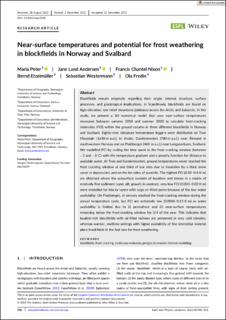| dc.description.abstract | Blockfields remain enigmatic regarding their origin, internal structure, surface processes, and glaciological implications. In Scandinavia, blockfields are found on high-elevation, low-relief mountains (plateaus) across the Arctic and Subarctic. In this study, we present a 1D numerical model that uses near-surface temperatures measured between summer 2018 and summer 2020 to calculate frost-cracking intensities (FCI) within the ground column in three different blockfields in Norway and Svalbard. Eighty-nine miniature temperature loggers were distributed on Tron Mountain (1650 m a.s.l.) in Alvdal, Gamlemsveten (780 m a.s.l.) near Ålesund in southwestern Norway and on Platåberget (460 m a.s.l.) near Longyearbyen, Svalbard. We modelled FCI by scaling the time spent in the frost cracking window (between −3 and −8°C) with the temperature gradient and a penalty function for distance to available water. At Tron and Gamlemsveten, ground temperatures never reached the frost cracking window at one third of our sites due to insulation by a thick snow cover in depressions and on the lee sides of summits. The highest FCI (0.05–0.4 K m) are obtained where the subsurface consists of boulders and stones in a matrix of relatively fine sediment (sand, silt, gravel). In contrast, very low FCI (0.003–0.02 K m) were modelled for blocky layers with large air-filled pores because of the low water availability. On Platåberget, all sensors reached the frost-cracking window during the annual temperature cycle, but FCI are extremely low (0.0004–0.15 K m) as water availability is limited due to (i) permafrost and (ii) near-surface temperatures remaining below the frost-cracking window for 3/4 of the year. This indicates that boulder-rich blockfields with air-filled hollows are preserved in very cold climates, whereas warmer, maritime settings with higher availability of fine interstitial material place blockfields in the fast lane for frost weathering. | en_US |

